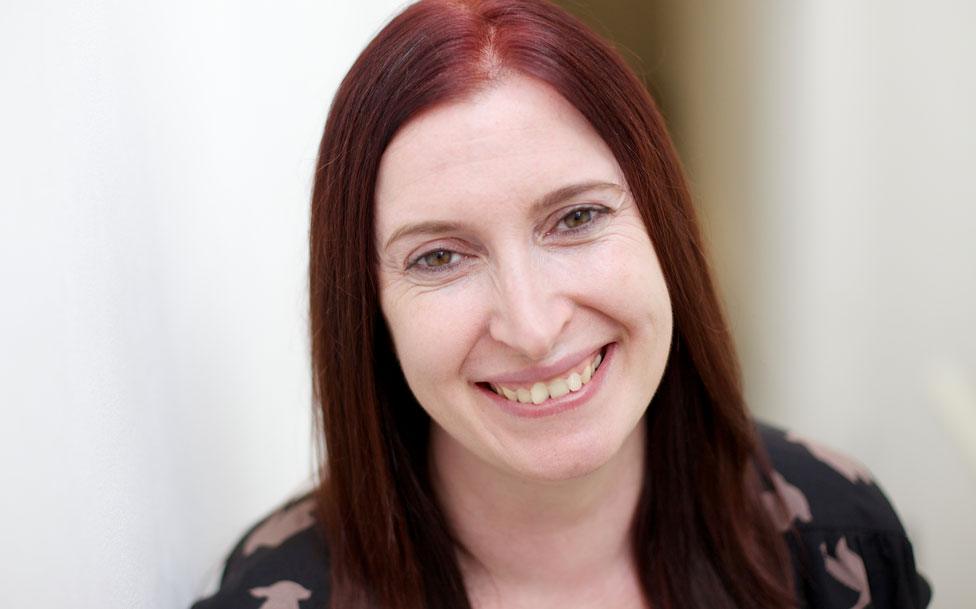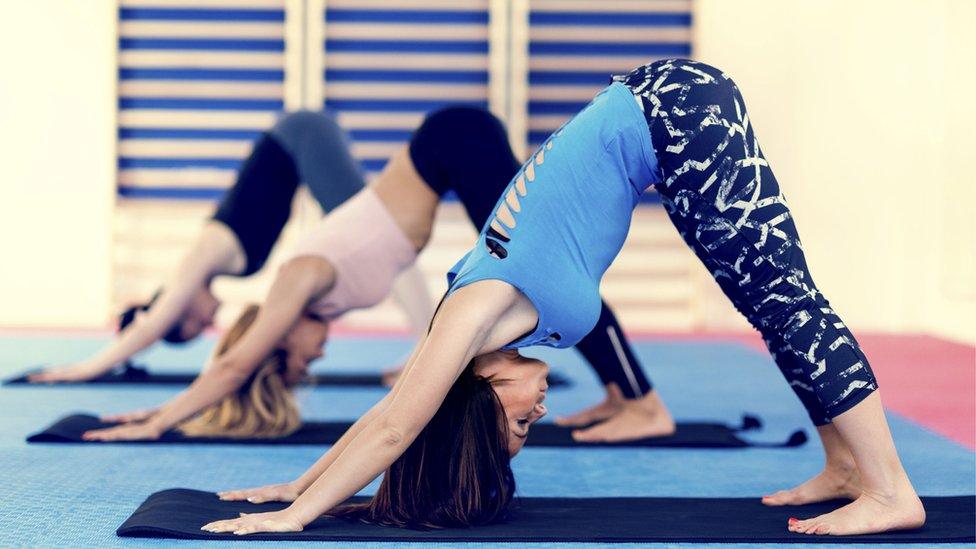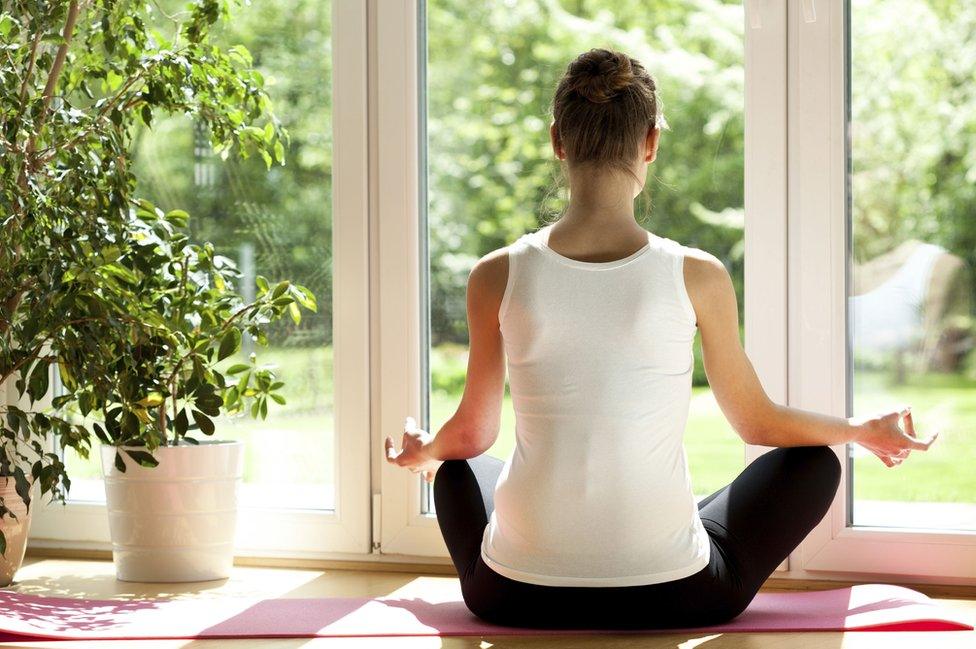How yoga helped balance my bipolar
- Published

Charlotte Walker has tried many things to control her bipolar disorder, including most recently an intensive course of yoga. So after 25 days of downward-facing dog, how did she feel?
Life with bipolar can be hard. Sometimes I sink into depression, incapable of getting out of bed, crying uncontrollably. When I'm high I barely pause to eat or sleep until I hit a wall of exhaustion and despair. It's always a struggle to find middle ground. I take medication and it helps, but I also try to manage my condition, external in other ways.
I find mindfulness particularly useful. Put simply, mindfulness involves noticing what's going on, not trying to relax or calm yourself, just paying attention to what you're feeling and thinking. Many people find observing their breath flowing in and out is a good way to stay mindful. I often write about the topic, external, so I was excited when someone called Rosie contacted me through my blog. The yoga studio she works in is trying to incorporate more mindfulness. Would I like to try 25 days of unlimited classes and share my thoughts?

Charlotte Walker - last did yoga in the 1990s
In the 1990s I was a major yoga fan. Daily practice of the poses or asanas, developed from early Hindu texts, helped calm my overactive mind. My psychiatrist encourages me to give it a go again and husband Tom is also supportive. "It's very reflective," he says. "Maybe it can help you gain more control over your emotions?" I tell Rosie yes please, but I'm nervous. It's been challenging enough just staying out of hospital this year
I book three classes for the first week, though am anxious it will be too much for me. I'm also struggling with body image. Can I get into the asanas at the size I am now? Will I be the most overweight person there? Rosie reassures me. "Yoga's non-judgmental. If anyone's there to judge, they're not practising yoga."
Things really have changed. In the 1990s there was just plain "yoga" taught in draughty church halls, but now there's a whole menu of styles. This studio specialises in power yoga, a dynamic practice of flowing from one pose to another. When I arrive there is no dusty parquet. The lights are dimmed, the air is scented and relaxation music plays. I pick a mat at the back so I can be rubbish in semi privacy. The music speeds up and we're off. Our teacher Lea keeps asking us to lower ourselves down facing the floor, first knees, chest, then chin. I manage the knees, but repeatedly fall forwards. Face, meet mat. You'll be seeing a lot of each other.

Downward-facing dog...
My muscles shake with fatigue and I'm relieved to lie down and relax. Eyes closed, I'm surprised when Lea moves behind me, massaging my forehead with scented oil. I'm agonistic at best, but as she presses her thumb between my eyebrows I feel like a child of God. Corny, but true.
The second class is in a larger, brighter room - there's nowhere to hide. I remind myself I have every right to be there, but my tranquillity is short-lived as I commit the cardinal sin of accidentally lying on someone else's mat. The session's tough and I fall over a lot, but at least I'm not the only one with body worries. Teacher Christian looks on with amusement at the mass tugging of leggings. "No need to adjust your clothes yogis, you all look beautiful!"
My brain dredges up long-forgotten names of yoga positions. Cobra. Bow. Cat. Downward-facing dog. Lots of downward-facing dog. I've never spent so much time with my bum stretched towards the ceiling. I'm just getting used to it again when Christian asks us to step one foot between our hands. He has to be kidding?
Apparently not.
I try a different style of class. In yin yoga each pose is held for several minutes. Looking deep within, accepting and working with intense sensations is a different sort of challenge. At first I feel slightly panicky. Being in physical discomfort is a bit too much like being in emotional discomfort. As I release the final deep bend I feel a sense of real achievement. I stuck with it. It's been the hardest class yet.

After a couple of weeks every session still feels the hardest I've done. Even with the same teacher the mix of poses and the energy level differ. One constant is the commitment to mindfulness. Breathing is at the heart of yoga, and many people see it as a kind of moving meditation. At the start of each class we're reminded to work with our breath. Inhale, stretch, lengthen. Exhale, relax, release. A phrase from one class sticks in my mind - "without breath, yoga's just shapes."
We're asked to set an intention for practice, something I'm used to from meditation classes. Why am I here? What do I want to achieve? I have a sudden light bulb moment. Everything I want to achieve physically is exactly what I want to achieve mentally. I want to be strong. I want to be stable. I want to achieve balance. I want control.
I find myself back where I started on the very same mat. The session is hard but I glimpse progress. My foot won't go between my hands, but it's edging closer. My upper body is stronger so there's less face to mat action. Astonishingly, I've managed six classes in the last six days and 16 overall. I feel better mentally and physically, and see less separation between the two. I keep seeing muscles I didn't know I had and I haven't had abs like this in years. Tom says I'm more balanced and people keep telling me how well I look.
Internally, I feel a lightness I want to hold onto. Stressful events aren't so stressful. I'm not so swamped by anxiety. I still get the odd elated day or occasional low but class seems to balance me out. Yoga's become part of my life again and there's no question about it, I will definitely continue. It's helped me find the middle ground and I'm pitching my tent there.
Charlotte Walker blogs as Purple Persuasion, external.
For more Disability News, follow BBC Ouch on Twitter, external and Facebook, external, and subscribe to the weekly podcast.